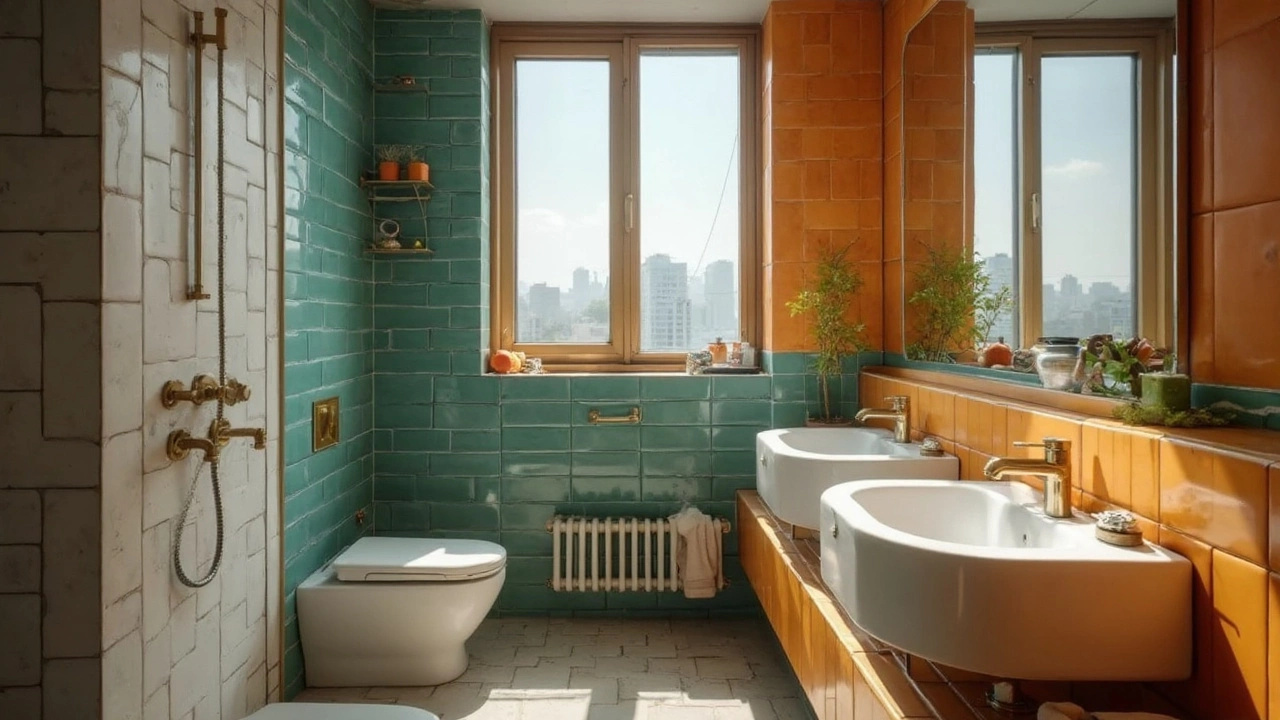Ten grand for a full bathroom renovation sounds almost too good to be true, right? The truth is, how far your $10,000 goes depends on a bunch of factors: the size of your bathroom, your taste in finishes, and whether you’re willing to get your hands dirty.
Before you even call a contractor, know this: labor eats up a huge chunk of a bathroom remodel budget—sometimes half or more. That means every task you can tackle yourself (like demo, painting, or swapping out simple fixtures) gives you more to spend elsewhere. Prices for fixtures and materials can swing wildly too. A so-so vanity might set you back $250, but a fancy one can climb up to $2,000—just for the cabinet under your sink!
Shopping around is your new superpower. Online deals, neighborhood salvage stores, and even creative upcycling can slash hundreds off your final bill. Ever heard of people reusing a dresser as a vanity? It saves cash and looks cool. Choosing where to splurge is key—nobody wants a wobbly toilet but skipping $20 per tile in favor of a solid $3 option might free up cash for a fun new showerhead or better lighting.
- Setting a Realistic Budget
- Where to Save and Where to Splurge
- Common Mistakes That Blow Your Budget
- Low-Cost Upgrades That Wow
Setting a Realistic Budget
First things first—let’s break down how bathroom renovation dollars really get spent. It’s easy to get sticker shock if you walk into a big box store and price out the fanciest things, but the real game is knowing what’s essential, what’s optional, and what you can actually afford.
On average, the cost split for a mid-range $10,000 bathroom remodel in the U.S. looks something like this:
| Category | Typical % of Budget | Estimated Dollars |
|---|---|---|
| Labor | 40-55% | $4,000-$5,500 |
| Fixtures & Fittings | 20-30% | $2,000-$3,000 |
| Flooring & Tile | 10-15% | $1,000-$1,500 |
| Paint & Walls | 5-10% | $500-$1,000 |
| Lighting & Electric | 5-10% | $500-$1,000 |
That shows pretty fast that if you want all-new everything, your budget remodel is gonna require some trade-offs. For example, keeping your bathroom layout the same saves thousands, since moving plumbing and electric is where things get expensive. Most folks don’t realize that even a small move—like shifting the toilet or shower—can mean tearing up floors and walls, then putting everything back together. That’s both time and cash disappearing.
Another overlooked trick is phasing. Can you live with your tub another year and just handle surfaces now? Tackle big-ticket items later if money gets tight. Phased upgrades mean you spend money where it matters most right now, and you don’t go into debt chasing the perfect bathroom all at once.
To really dial in your budget, grab a spreadsheet or even a napkin and plot out:
- What must be replaced right away? (Think: leaky toilet, broken faucet, moldy drywall)
- What can you refresh without a total replacement? (Paint, hardware, mirrors)
- How much can you honestly do yourself?
- Which parts are worth hiring out? (Tile and plumbing usually need a pro if you’re not handy)
The key? Don’t just dream what’s possible—map out the numbers so you know exactly where your affordable upgrades can have the biggest impact. With concrete targets instead of vague wishes, you’ll keep the whole project on track and totally dodge that “why did we ever start this?!” regret.
Where to Save and Where to Splurge
When you’re aiming for a $10,000 bathroom renovation, figuring out where to spend and where to cut back makes all the difference. Not everything needs to be high-end, but some things definitely aren’t worth skimping on.
If your plumbing and electrical are still in good shape, keep them where they are. Moving plumbing around is one of the fastest ways to watch your budget vanish. On average, moving a toilet or shower could cost you $1,500 or more per fixture. Keeping major pieces put saves you thousands to use elsewhere.
It pays to put your money into key areas that you’ll touch or notice every day. Here’s where to splurge and where to save:
- Splurge: Shower and Tub Fixtures – Cheap shower valves and faucets wear out fast. Spend a little extra here for something that’s reliable and feels solid. A decent mid-range shower system could run $350-$600, but it’s worth it for daily comfort and hassle-free use.
- Save: Tile – Tile can get crazy expensive. Instead of full marble or designer patterns, use affordable subway tile or larger format porcelain for most surfaces. Smaller accent areas (like a strip behind the vanity) let you add personality for a lot less money.
- Splurge: Toilet – No one wants to deal with clogs or leaks. Mid-range toilets ($250-$400) flush better and last longer than bargain-bin models.
- Save: Vanity – Skip the custom built-ins and look for stock vanities at stores like IKEA or Home Depot. Or, for the crafty folks, turn a thrifted dresser into a unique piece. You can often get a great look for $300-$600 instead of $1,500+.
- Splurge: Lighting – The right lights make even cheap materials look better. Quality LED fixtures ($75-$200 each) burn less power and make the space feel bigger and cleaner.
- Save: Paint and Accessories – Grab a good, moisture-resistant paint and nice towels or mirrors. The finishing touches don’t have to be designer brands to look sharp.
Curious where most of your bathroom renovation money goes? Check this typical budget breakdown:
| Area or Item | Typical Cost % |
|---|---|
| Labor | 40%–60% |
| Fixtures (toilet, shower, vanity) | 20%–30% |
| Finishes (tile, paint, accessories) | 10%–20% |
| Lighting | 5%–10% |
The smart move? Splurge where quality pays off daily and hunt for value everywhere else. Your new bathroom remodel doesn’t have to cost a fortune, but you want it to last. You might even be surprised how far your money goes when you strike the right balance.

Common Mistakes That Blow Your Budget
Trying to pull off a bathroom renovation for $10,000? Plenty of people go over by thousands—all because of a few easy-to-avoid blunders. Here’s how most budgets go off the rails.
- Ignoring hidden problems: Water damage, mold, or ancient plumbing can pop up after you start demo. If you don’t leave room in your budget for surprises, you risk a half-finished space (or a way higher total cost).
- Changing your mind mid-project: Deciding halfway through that you want different tiles or a fancy tub can throw your budget remodel into chaos. Each change means more materials and labor, plus possibly wasted stuff you already bought.
- High-end tastes on a low-end budget: If you’re eyeing marble or heated floors, it adds up quick. Stick to quality basics for big surfaces and splurge on small touches if you want a luxe feel without the price tag.
- Forgetting about the small stuff: It’s easy to focus on vanities or showers and forget things like towel bars, mirrors, or plumbing fittings. All those extras can sneak up and total several hundred dollars.
- Doing everything at once: Tearing out the whole bathroom on day one leaves you with zero wiggle room. Remedy: Plan, price it all, and line up everything before you gut.
- Blowing money on labor you could do yourself: Demo, painting, installing mirrors, changing hardware—these are doable without pro skills. Save your cash for jobs that really need a pro, like plumbing or electrical work.
Check this out—here’s how budgets typically get eaten up in a $10,000 bathroom remodel:
| Expense | Typical Cost |
|---|---|
| Labor | $4,000–$5,000 |
| Fixtures & Fittings | $2,000–$3,000 |
| Tiles, Paint, Flooring | $1,000–$1,500 |
| Surprises (mold, plumbing) | $1,000+ |
| Extras (mirrors, lights) | $500–$1,000 |
Stick to your plan, don’t skip prep, and always keep at least 15% of your $10,000 bathroom budget as a backup. That’s the difference between finishing proud and staring at a half-demo project next month.
Low-Cost Upgrades That Wow
Never underestimate what a few smart, affordable upgrades can do for your bathroom. You don’t have to gut the whole space to make it look fresh and updated. Here’s where you get the most bang for your buck—no sledgehammer required.
- Paint does wonders. For $50–$100, a gallon or two of paint can turn a dingy bathroom into something that looks brand new. Lighter colors help small bathrooms feel bigger, while navy or deep green adds drama without much risk or cost.
- Swap your fixtures. Replacing faucets, cabinet pulls, and showerheads is surprisingly easy and often under $300 total if you shop smart. Matte black and brushed gold are all over Instagram right now, but classic chrome never goes out of style.
- Upgrade the lighting. Old fixtures can make a bathroom feel dreary. Swapping them out for modern LED options instantly brightens up the space—and can save money on electricity, too. Some decent fixtures cost less than $100 each.
- Refresh your grout and caulk. Nothing dates a bathroom faster than grimy grout. Bleach and a scrub brush do wonders, but if it’s past saving, regrouting isn’t hard and costs less than $50 if you DIY. Fresh caulk around the tub keeps it looking tidy and safe from water damage.
- Add statement mirrors or open shelving. Mirrors make spaces feel larger and more open. Stores like IKEA have basic options for under $70, but you can also find vintage mirrors at antique shops or flea markets for the same price. Open shelves (which you can make with reclaimed wood and brackets) offer storage and give you a spot to show off plants or rolled towels.
For folks who want a quick view of how costs can add up, check out what a few upgrades might look like:
| Upgrade | Average Cost |
|---|---|
| Paint (DIY) | $100 |
| New Faucet & Handles | $150 |
| LED Light Fixture | $90 |
| Mirror | $70 |
| Grout/Caulk Refresh | $50 |
That’s under $500 for a huge visual impact. Small moves like these let you stick to your bathroom renovation budget and still end up with a space that feels pulled together and modern. If you only have the energy for one upgrade, prioritize lighting—it changes everything, trust me. Lydia and I replaced the yellowed old dome light in our guest bath with a sleek $65 LED, and suddenly the space looked twice as nice.

Written by Fletcher Abernathy
View all posts by: Fletcher Abernathy